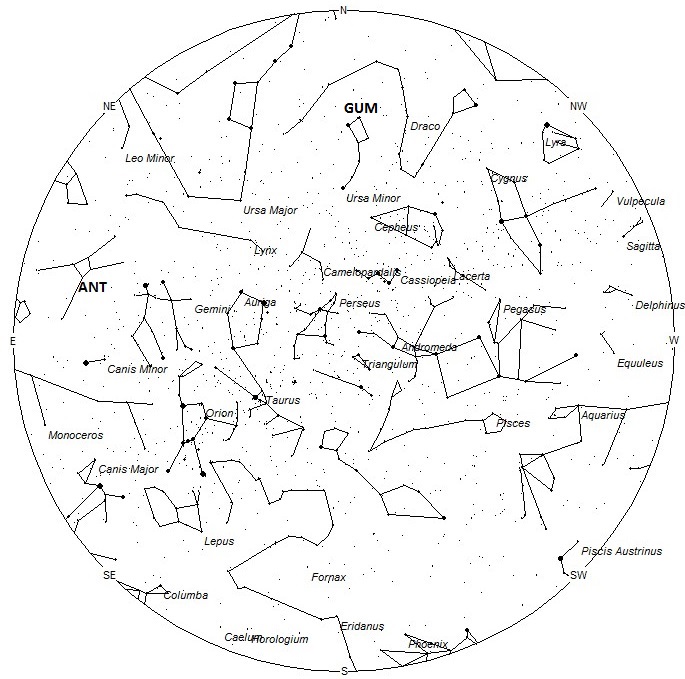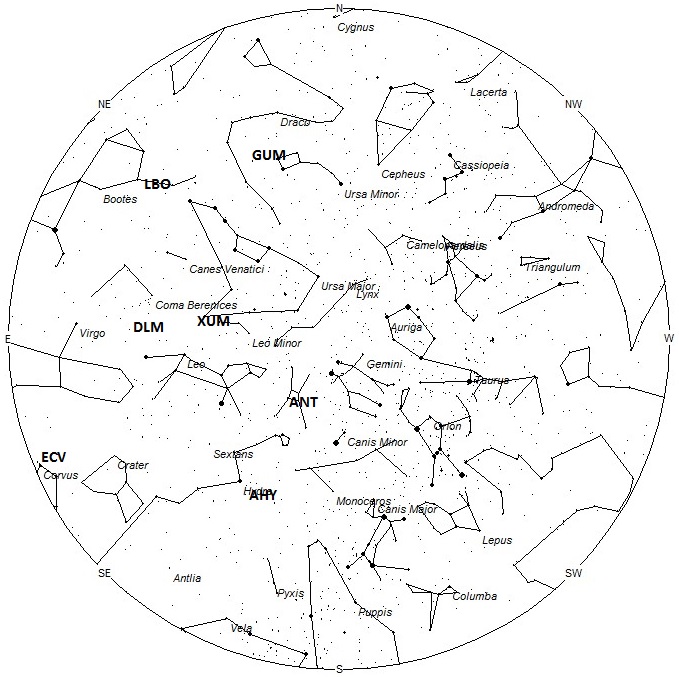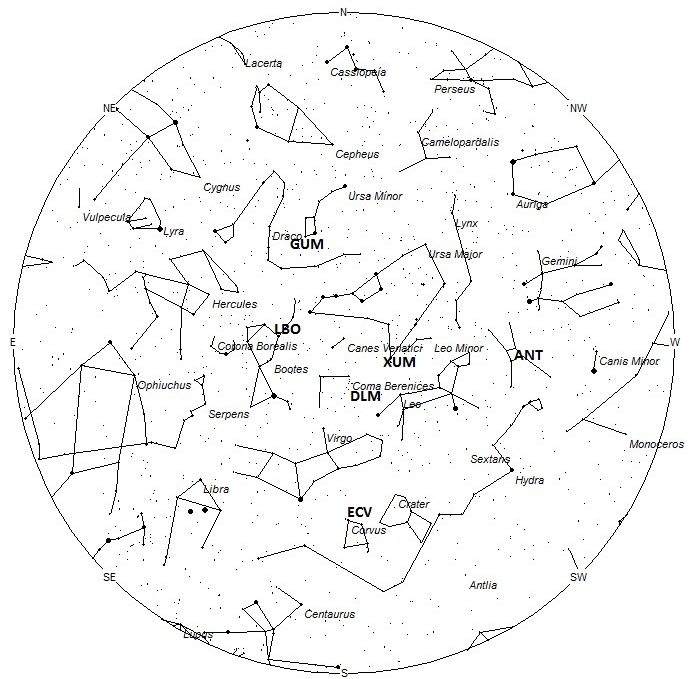
During this period the moon will reach its new phase on Wednesday January 17th. At that time the moon will lie near the sun and will be invisible at night. This weekend the waning crescent moon will rise during the early morning hours but will not interfere with meteor observing. The estimated total hourly meteor rates for evening observers this week is near 4 no matter your location. For morning observers the estimated total hourly rates should be near 13 as seen from mid-northern latitudes and 11 from the southern tropics. The actual rates will also depend on factors such as personal light and motion perception, local weather conditions, alertness and experience in watching meteor activity. Note that the hourly rates listed below are estimates as viewed from dark sky sites away from urban light sources. Observers viewing from urban areas will see less activity as only the brighter meteors will be visible from such locations.
The radiant (the area of the sky where meteors appear to shoot from) positions and rates listed below are exact for Saturday night/Sunday morning January 13/14. These positions do not change greatly day to day so the listed coordinates may be used during this entire period. Most star atlases (available at science stores and planetariums) will provide maps with grid lines of the celestial coordinates so that you may find out exactly where these positions are located in the sky. A planisphere or computer planetarium program is also useful in showing the sky at any time of night on any date of the year. Activity from each radiant is best seen when it is positioned highest in the sky, either due north or south along the meridian, depending on your latitude. It must be remembered that meteor activity is rarely seen at the radiant position. Rather they shoot outwards from the radiant so it is best to center your field of view so that the radiant lies near the edge and not the center. Viewing there will allow you to easily trace the path of each meteor back to the radiant (if it is a shower member) or in another direction if it is a sporadic. Meteor activity is not seen from radiants that are located far below the horizon. The positions below are listed in a west to east manner in order of right ascension (celestial longitude). The positions listed first are located further west therefore are accessible earlier in the night while those listed further down the list rise later in the night.
These sources of meteoric activity are expected to be active this week.
.
The center of the large Anthelion (ANT) radiant is currently located at 08:24 (126) +19. This position lies in central Cancer, 4 degrees west of the 4th magnitude star known as Asellus Australis (delta Cancri). Due to the large size of this radiant, Anthelion activity may also appear from eastern Gemini, and western Leo, as well as Cancer. This radiant is best placed near 0100 local standard time (LST), when it lies on the meridian and is located highest in the sky. Rates at this time should be near 3 per hour as seen from the northern hemisphere and 2 per hour from south of the equator. With an entry velocity of 30 km/sec., the average Anthelion meteor would be of slow velocity.
The alpha Hydrids (AHY) are still active from a radiant located at 09:08 (137) -11. This area of the sky lies about 4 degrees southwest of the 2nd magnitude star Alphard (alpha Hydrae). These meteors are best seen near 02:00 LST when the radiant lies highest above the horizon. Rates should be less than 1 per hour no matter your location. These meteors encounter the atmosphere at 43 km/sec., which would produce meteors of average velocity.
The January xi Ursae Majorids (XUM) is a shower discovered by Japanese observers of SonotoCo based on video observations in 2007-2008. This shower is active from January 15-22, with maximum activity occurring on the 18th. At maximum the radiant is located at 11:15 (169) +33, which lies in southwestern Ursa Major, just west of the 3rd magnitude star known as Alula Borealis (xi Ursae Majoris). These meteors are best seen near 04:00 LST when the radiant lies highest above the horizon. Hourly rates should be near 1 as seen from the northern hemisphere and less than 1 as seen south of the equator. These meteors encounter the atmosphere at 41 km/sec., which would produce meteors of average velocity.
The December Leonis Minorids (DLM) are active from a radiant located at 12:08 (182) +20. This position lies in western Coma Berenices, 6 degrees northeast of the 2nd magnitude star known as Denebola (beta Leonis). These meteors are best seen near 0400 LST when the radiant lies highest above the horizon. This shower peaked on December 20th so current rates would be less than 1 per hour no matter your location. At 63 km/sec. the December Leonis Minorids produce mostly swift meteors.
The eta Corvids (ECV) were recently discovered by Sirko Molau and the IMO Video Meteor Network Team. This stream is active from January 16-29, with maximum activity occurring on the 22nd. The current position of the radiant is 12:20 (185) -14, which places the radiant in northern Corvus, 3 degrees northwest of the 3rd magnitude star known as Algorab (delta Corvi). These meteors are best seen near 0400 LST when the radiant lies highest above the horizon. Current hourly rates would be less than 1 per hour no matter your location. At 68 km/sec. these meteors would be fast.
The lambda Bootids (LBO) were discovered by Dr. Peter Brown and his team at the University of Western Ontario, London, Ontario, Canada. They were using radar means to discover new streams. These meteors are active from December 31 through January 17 with maximum activity occurring on the 16th. The radiant currently lies at 14:36 (219) +44. This position lies on the in northwestern Bootes between beta and lambda Bootis. This is also very close to the faint star known as 33 Bootis. Current rates are expected to be less than 1 per hour. At 41 km/sec. these meteors are of medium velocity.
The gamma Ursae Minorids (GUM) were discovered also discovered by Dr. Peter Brown and associates. These meteors are active from January 09-20, with maximum occurring on the 18th. The radiant is currently located at 15:12 (228) +70, which places it southern Ursa Minor, 2 degrees south of the 3rd magnitude star known as Pherkad (gamma Ursae Minoris). These meteors are best seen during the last few hours before dawn, when the radiant lies highest in a dark sky. Expected rates are less than 1 per hour during this period no matter your location. For viewer in the northern hemisphere hourly rates may be close to 1 on the night of maximum activity (Jan 18). Unfortunately these meteors are not visible from the southern hemisphere. These meteors encounter the atmosphere at 30 km/sec., which would produce meteors of medium-slow velocity.
As seen from the mid-northern hemisphere (45N) one would expect to see approximately 9 sporadic meteors per hour during the last hour before dawn as seen from rural observing sites. Evening rates would be near 3 per hour. As seen from the tropical southern latitudes (25S), morning rates would also be near 9 per hour as seen from rural observing sites and 3 per hour during the evening hours. Locations between these two extremes would see activity between the listed figures.
| SHOWER | DATE OF MAXIMUM ACTIVITY | CELESTIAL POSITION | ENTRY VELOCITY | CULMINATION | HOURLY RATE | CLASS |
| RA (RA in Deg.) DEC | Km/Sec | Local Standard Time | North-South | |||
| Anthelion (ANT) | – | 08:24 (126) +19 | 30 | 01:00 | 3 – 2 | II |
| alpha Hydrids (AHY) | Jan 03 | 09:08 (137) -11 | 43 | 02:00 | <1 – <1 | IV |
| January xi Ursae Majorids (XUM) | Jan 18 | 11:15 (169) +33 | 41 | 04:00 | 1 – <1 | IV |
| December Leonis Minorids (DLM) | Dec 21 | 12:08 (182) +20 | 63 | 05:00 | <1 – <1 | II |
| eta Corvids (ECV) | Jan 22 | 12:20 (185) -14 | 68 | 05:00 | <1 – <1 | IV |
| lambda Bootids (LBO) | Jan 16 | 14:36 (219) +44 | 41 | 07:00 | <1 – <1 | IV |
| gamma Ursae Minorids (GUM) | Jan 18 | 15:12 (228) +70 | 30 | 08:00 | <1 – <1 | IV |
 American Meteor Society
American Meteor Society



Yesterday, January 14 a loud noise that sounded like a sonic boom occurred at our house during the afternoon. I thought a tree limb had landed on the roof but after inspection it wasn’t. I do not know what made the noise and if this was part of this new of meteors.
I heard the most massive BOOM like ONE single crash of thunder like I never heard before at 0445hrs Bern Switzerland this morning Wed 17th January 2018. There has been very moody dark rain clouds and very bustly high winds here these past couple of days too, but no lightning.
I saw a green ball of light in Murfreesboro Tennessee at 11 p.m. Central Time.
Washington, DC
1/19/2018 – 6:48pm EST, in Orion, looking East, direction down to horizon (was photographing Orion)
1/20/2018 – 1:50:14pm EST, looking west north west – to the right of Capella, direction down to horizon (my webcam caught it).
Good morning. I live in Chula Vista, CA. At approximately 5:20 AM this morning (01/23/18) as I was beginning my morning commute, I saw a shooting star in the NW sky. I saw the tail first, then a quick bright, white flash. In our area, the sun rises at about 6:45 AM this time of year, so it was still quite dark enough to see well.
Memphis, TN
1/30/2018 – approximately 3:20 AM CST I was awaken by a very loud Boom. Sounded like lightening hitting or thunder, but no rain clouds were in the area. Strange that no house or car alarms went off. It is confusing, but I know something loud woke me up enough to investigate around the house.